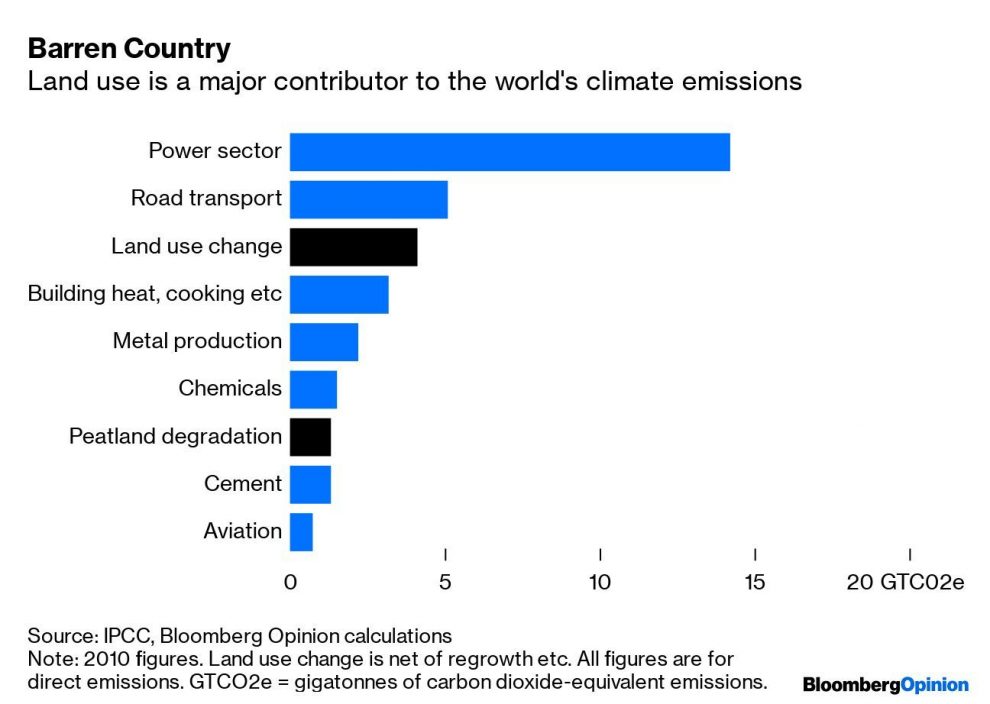
(Bloomberg Opinion) — The fires currently consuming Brazil’s Amazon rainforest seem a world away from the tense diplomacy in the U.S. trade war with China. In truth, they’re more closely connected than you might suspect.
One of Beijing’s main acts of retaliation in the fight has been to freeze purchases of the 30 million metric tons to 40 million tons of American soybeans it imports each year. That’s left it more dependent than ever on Brazilian soy to take up the slack. Chinese imports from Brazil in the 12 months through April came to 71 million tons, about as much as it imported from the entire world in 2014.
As we’ve written, that’s driving an investment boom into Brazil’s farm sector, with major agribusiness players such as Nutrien Ltd. and Mosaic Co. shifting their focus to South America to take advantage of Beijing’s desire to diversify away from dependence on U.S. food supplies.
In a sense, this shouldn’t have a direct impact on the Amazon. Most Brazilian soy is grown in the cerrado, a vast area of savannah to the south and east of the rainforest. Agricultural investment has concentrated on converting cerrado land currently used for pasturing livestock into row-crops like soybeans.
That process should be able to result in a huge expansion of arable land without touching the Amazon. The trouble is, even Brazil has a finite amount of land and if you squeeze the balloon in one place, it risks popping out in another. As it is, most of the expansion of Brazil’s arable land over the past decade appears to have come at the expense of regrowth forest, which tends to be less well-protected than primary forest like the Amazon. This year’s fires could see ranchers driven out of the cerrado by arable crops to seek new pastures in freshly-cleared former rainforest in the Amazon.
That’s particularly dispiriting because preservation campaigns appear to have started paying off in recent years, with clearing of Brazil’s primary rainforest almost brought to a halt over the past decade despite the ongoing felling of regrowth woodlands. President Jair Bolsonaro has already promised a more aggressive approach to developing the Amazon, scorning environmental concerns and jokingly referring to himself as “Captain Chainsaw.”
Even when activity is kept away from the Amazon, land conversion has a damaging effect on the atmosphere. Brazil’s cerrado pastureland can be quite densely forested, with livestock grazing beneath the open canopy of the trees. Converting that to row crops necessitates uprooting those carbon-sequestering trunks, one reason it’s such a costly and difficult process. In addition, pastureland trampled by livestock is quite effective at locking atmospheric carbon up in the soil, but arable fields tilled every year fail to make as much difference.
It’s still hard to tell exactly who is responsible for the 84% increase in fires in Brazil’s forests over the past year. The intensity of the infernos is likely the result of drought, although the rising number of blazes almost certainly comes from an increase in deliberate human activity. More than half of outbreaks have been in the Amazon, with another 30% in the cerrado and most of the rest in the coastal Atlantic forest.
The danger of the current situation is that China’s hunger for soy may derail the halting recent progress in ending deforestation. The European Union in June concluded a trade agreement with the South American Mercosur bloc after two decades of negotiation, but Bolsonaro’s insouciant attitude to the Amazon represents a stumbling bloc for European governments who are needed to ratify the deal. Brazil’s agribusiness sector has even lobbied Bolsonaro’s government to take greater steps to halt deforestation, out of fear that his confrontational stance could jeopardize the EU-Mercosur deal and hurt their exports.
China, on the other hand, tends to be a much more hands-off trading partner, and long-standing concerns about food security mean Beijing has been unusually solicitous of Brazil’s approval. If anything could nudge Bolsonaro toward ignoring his country’s land barons and following his instincts instead, it’s the prospect of a rich alternative source of foreign exchange from China.
This would be a miserable and unexpected outcome from the current trade war. Despite coming to office on a pledge to revive the coal industry and tear up environmental rules, President Donald Trump has mostly failed to reverse the greening of America’s power sector and the auto industry’s drive toward lower tailpipe emissions.
His trade fight with an equally carbon-addicted China, however, encouraged that country to embark on a ruinously carbon-intensive industrial stimulus last year, and may now be driving Brazil to uproot more of its forests. The grimmest climate legacy of the Trump administration may well come not from energy policy, but from trade.
To contact the author of this story: David Fickling at [email protected]
To contact the editor responsible for this story: Patrick McDowell at [email protected]
This column does not necessarily reflect the opinion of the editorial board or Bloomberg LP and its owners.
David Fickling is a Bloomberg Opinion columnist covering commodities, as well as industrial and consumer companies. He has been a reporter for Bloomberg News, Dow Jones, the Wall Street Journal, the Financial Times and the Guardian.
<p class="canvas-atom canvas-text Mb(1.0em) Mb(0)–sm Mt(0.8em)–sm" type="text" content="For more articles like this, please visit us at bloomberg.com/opinion” data-reactid=”64″>For more articles like this, please visit us at bloomberg.com/opinion
©2019 Bloomberg L.P.






